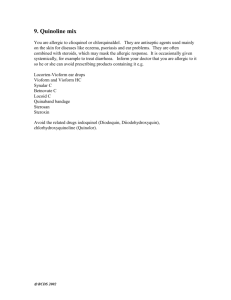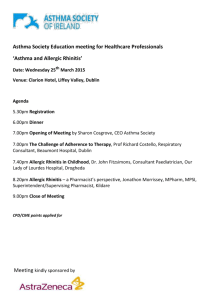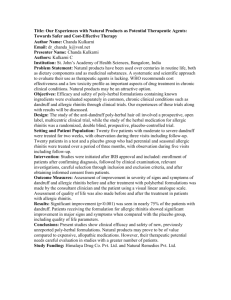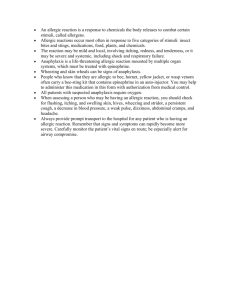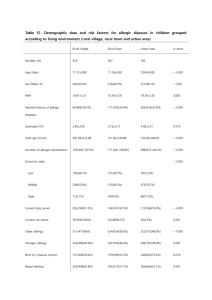Document 13310641
advertisement
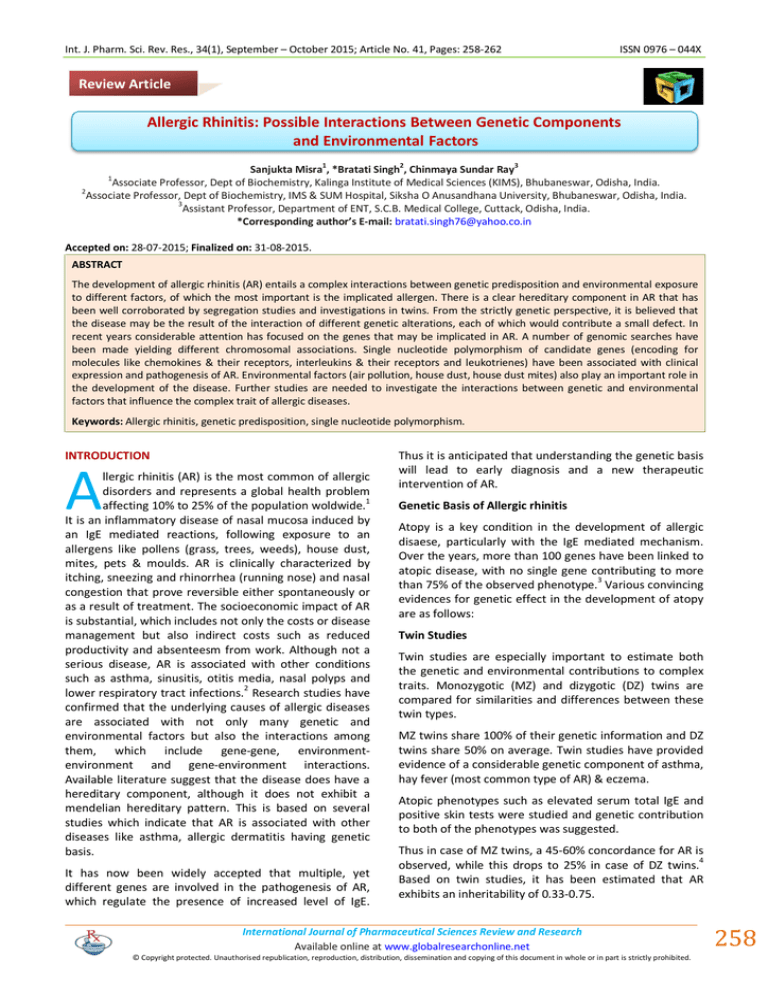
Int. J. Pharm. Sci. Rev. Res., 34(1), September – October 2015; Article No. 41, Pages: 258-262 ISSN 0976 – 044X Review Article Allergic Rhinitis: Possible Interactions Between Genetic Components and Environmental Factors 1 2 3 Sanjukta Misra , *Bratati Singh , Chinmaya Sundar Ray Associate Professor, Dept of Biochemistry, Kalinga Institute of Medical Sciences (KIMS), Bhubaneswar, Odisha, India. 2 Associate Professor, Dept of Biochemistry, IMS & SUM Hospital, Siksha O Anusandhana University, Bhubaneswar, Odisha, India. 3 Assistant Professor, Department of ENT, S.C.B. Medical College, Cuttack, Odisha, India. *Corresponding author’s E-mail: bratati.singh76@yahoo.co.in 1 Accepted on: 28-07-2015; Finalized on: 31-08-2015. ABSTRACT The development of allergic rhinitis (AR) entails a complex interactions between genetic predisposition and environmental exposure to different factors, of which the most important is the implicated allergen. There is a clear hereditary component in AR that has been well corroborated by segregation studies and investigations in twins. From the strictly genetic perspective, it is believed that the disease may be the result of the interaction of different genetic alterations, each of which would contribute a small defect. In recent years considerable attention has focused on the genes that may be implicated in AR. A number of genomic searches have been made yielding different chromosomal associations. Single nucleotide polymorphism of candidate genes (encoding for molecules like chemokines & their receptors, interleukins & their receptors and leukotrienes) have been associated with clinical expression and pathogenesis of AR. Environmental factors (air pollution, house dust, house dust mites) also play an important role in the development of the disease. Further studies are needed to investigate the interactions between genetic and environmental factors that influence the complex trait of allergic diseases. Keywords: Allergic rhinitis, genetic predisposition, single nucleotide polymorphism. INTRODUCTION A llergic rhinitis (AR) is the most common of allergic disorders and represents a global health problem affecting 10% to 25% of the population woldwide.1 It is an inflammatory disease of nasal mucosa induced by an IgE mediated reactions, following exposure to an allergens like pollens (grass, trees, weeds), house dust, mites, pets & moulds. AR is clinically characterized by itching, sneezing and rhinorrhea (running nose) and nasal congestion that prove reversible either spontaneously or as a result of treatment. The socioeconomic impact of AR is substantial, which includes not only the costs or disease management but also indirect costs such as reduced productivity and absenteesm from work. Although not a serious disease, AR is associated with other conditions such as asthma, sinusitis, otitis media, nasal polyps and lower respiratory tract infections.2 Research studies have confirmed that the underlying causes of allergic diseases are associated with not only many genetic and environmental factors but also the interactions among them, which include gene-gene, environmentenvironment and gene-environment interactions. Available literature suggest that the disease does have a hereditary component, although it does not exhibit a mendelian hereditary pattern. This is based on several studies which indicate that AR is associated with other diseases like asthma, allergic dermatitis having genetic basis. It has now been widely accepted that multiple, yet different genes are involved in the pathogenesis of AR, which regulate the presence of increased level of IgE. Thus it is anticipated that understanding the genetic basis will lead to early diagnosis and a new therapeutic intervention of AR. Genetic Basis of Allergic rhinitis Atopy is a key condition in the development of allergic disaese, particularly with the IgE mediated mechanism. Over the years, more than 100 genes have been linked to atopic disease, with no single gene contributing to more than 75% of the observed phenotype.3 Various convincing evidences for genetic effect in the development of atopy are as follows: Twin Studies Twin studies are especially important to estimate both the genetic and environmental contributions to complex traits. Monozygotic (MZ) and dizygotic (DZ) twins are compared for similarities and differences between these twin types. MZ twins share 100% of their genetic information and DZ twins share 50% on average. Twin studies have provided evidence of a considerable genetic component of asthma, hay fever (most common type of AR) & eczema. Atopic phenotypes such as elevated serum total IgE and positive skin tests were studied and genetic contribution to both of the phenotypes was suggested. Thus in case of MZ twins, a 45-60% concordance for AR is observed, while this drops to 25% in case of DZ twins.4 Based on twin studies, it has been estimated that AR exhibits an inheritability of 0.33-0.75. International Journal of Pharmaceutical Sciences Review and Research Available online at www.globalresearchonline.net © Copyright protected. Unauthorised republication, reproduction, distribution, dissemination and copying of this document in whole or in part is strictly prohibited. 258 © Copyright pro Int. J. Pharm. Sci. Rev. Res., 34(1), September – October 2015; Article No. 41, Pages: 258-262 Seggregation Analyses Seggregation analyses are used to model inheritance patterns in families. The distribution of a disease is studied in families and the observed frequency of the disorder in offspring and siblings is compared to the expected distribution using different genetic models of inheritance. Different genetic models have been found for total serum IgE. Several explanations may be given for these different findings. The first explanation may be the variable definition of atopy between studies. Secondarily the ascertainment of families for segregation studies may play a role. A final explanation may be genetic heterogeneity. This means that in different populations, separate genes act in the regulation of these phenotypes. To date this can not be investigated since the exact locations of these genes are still unknown. Linage Analysis This is used to determine a chromosomal region which co-segregates with a certain trait within families. Linkage analysis requires a pedigree data as opposed to association studies, in which unrelated cases and controls are needed. In general, evidence for linkage is assumed to be present when the reviewed linkage from one study has been replicated by other. Identifying Atopic Disease Genes Till date considerable research effort has focussed on the genetic basis of asthma & atopic disease. However serious attention has been given on the genes that may be implicated in allergic rhinitis, curiously with particular emphasis on Asian population. In the area of human genetic studies, many candidate genes have been identified using position cloning and linkage analysis tecchnique.5 Recently genome-wide searches in different human population, have contributed significantly to the mapping of atopic genes. In genome-wide screen, all the chromosomes are searched until the approximate location of the gene is discovered. Then the localisation of the gene is progressively refined by positional cloning, which implies identification of a gene from the chromosomal region that has been associated to the inheritance of the disease. At this point all the gene of the region in which a linkage has been detected are regarded as positional candidate gene. On the other hand, functional candidate genes refer to the selection of a gene relating to its function. To date, several genomewide screens for atopy have also been completed and more are on the way, including collaboration with biotechnology & pharmaceutical industries. Most candidate genes studied, have selected focus of interest on the basis of mapping of TH-2 type cytokines (IL-4 gene cluster), receptors (high affinity IgE receptors) and recognition genes (HLA-D complex). More recently researchers have considered genes encoding transcription factors (signal transducer and activator of transcription 6 i.e. STAT 6) and other mediators of inflammation (eg.5-lipooxygenase). The genome-wide ISSN 0976 – 044X search approach has shown an association between certain phenotype of allergic disease (rhinitis or asthma) with markers on more than 14 pairs of chromosomes (i.e. chromosome 1,2,3,5,6,7,9,11,12,13,14,16,17,19 and more). In independent studies, the most reproducible linkages included IL-4 gene cluster on 5q31-q33, HLA-D region on 6p21, the region that encodes the high affinity IgE-receptor gene (FCER1B) on 11q13, and a large region on chromosome 12q14-q24.33 that encodes several candidates for allergic disease like STAT 6, IFN-gamma, stem-cell factor & nitric oxide synthase-1.6 Most candidate genes studied so far are major players in TH 2 mediated immune response, which can be explained on the basis of Hygiene hypothesis.7 This states that insufficient stimulation on the TH 1 arm due to lack of exposure to specific infection or endotoxins, could lead to an overactive TH 2 arm, causing allergic disease (upregulation of IgE). So there exists a set of genes which are involved in different categoric phenotypes of allergic disease (eg-asthma, AR, eczema) and are involved in differential expression of each of these phenotypes, such as up regulation of IgE or inflammatory responsiveness. Total serum IgE Linkage of total serum IgE to chromosome 1, 2, 4, 5, 6, 7, 9, 11, 12, 13, 14, 15 and 16 has been found by several research groups. Replication of significant linkage has been found on chromosome 5, 11, 12. Specific IgE Linkage of specific IgE has been found on chromosome 1, 2, 4, 6, 7, 9, 12. There is only limited data available with regard to linkage of specific IgE to particular chromosome region. Polymorphism in Allergic rhinitis Variations in DNA sequence seen in over 1% of the population are referred to as polymorphism and those that result from a single base change are called single nucleotide polymorphism [SNP]. Since there is one SNP per 1000 base pair, it has been estimated that there are at least 4 millions of SNPs that contribute to all the different individual characteristics (height, weight, eye colour, type of skin etc). From the perspectives of human genetics, it seems that the majority of genetic variations that contribute to complex diseases, probably involve the interaction of several SNPs. SNPs can be located in encoding region and thus modifying the structure of protein by changing amino acids. These polymorphism can also occur in promoter region, there by altering protein expression. SNPs must meet the following criterias to contribute to a 8 disease process. It must induce an alteration in the function or in the expression of the genetic product and a linkage study must exist, confirming association to the disease. By reviewing literature, there are some interesting and promising polymorphism in genes related to atopy. International Journal of Pharmaceutical Sciences Review and Research Available online at www.globalresearchonline.net © Copyright protected. Unauthorised republication, reproduction, distribution, dissemination and copying of this document in whole or in part is strictly prohibited. 259 © Copyright pro Int. J. Pharm. Sci. Rev. Res., 34(1), September – October 2015; Article No. 41, Pages: 258-262 Polymorphism in CD14 gene CD14 gene is located on chromosome 5q31. It is an important high affinity receptor for lipopolysaccharide. So binding of LPS to CD14 can provide activation signal for TH-1. IgE synthesis is controlled by inhibitory cytokines from TH-1 cells and by stimulating cytokines provided by TH-2 cells.9 Polymorphism in genes encoding IL & IL receptor Due to implication of many cytokines in the pathogenesis of AR, possibly most genetic studies have involved genes encoding for cytokines and their receptors. In an adult Korean population study, Chae studied 7 exons and the limiting introns of the sequence of IL-28 RA, including the promoter region and identified first SNP & 2 variation sites.10 Polymorphism also have been described in genes encoding for IL, not related to susceptibility to AR, or which even exert a protective effect against such disease. Polymorphism in gene encoding for chemokines & receptors Chemokines and their receptors are essential for chemotaxis of different inflammatory cells towards allergic inflammatory foci.11 Polymorphism in peroxidase (EPO) genes encoding for eosinophil Eosinophils play an important role in allergic rhinitis. It has been found that polymorphism of Pro 358 Leu of EPO to be implicated in the development of Japanese cedar pollinosis, which could be due to linkage imbalance between exon 6 and 7 of the EPO gene. Polymorphism in gene leukotrienes/lipoxygenase pathway encoding for Leukotrienes are important mediators implicated in the physiopathology of asthma & allergic rhinitis. Drugs capable of modulating leukotriene action have been used to treat asthma and recently they also have been approved for the treatment of allergic disease. LTC4 synthase (LTC4S) is the most important enzyme in the leukotriene synthetic pathway and the polymorphism of A-444C of LTC4 gene has been contradictory.12 Few studies have also been made in the setting of AR. Inherent difficulties in genetic studies of allergic disease Defining the clinical phenotype has been one of the major challenges in genetic studies of allergic diseases. This is even more applicable to allergic rhinitis and atopic dermatitis, in which there are no physiologic measurements on which to base an absolute diagnosis and in which diagnosis is based primarily on subjective symptoms (eg. runny stuffy nose, pruritus). This is in contrast with other complex disease in which quantitative traits or a series of measurable bio-markers have proved useful in teasing out susceptible genes. For example-PSA in prostate cancer, fasting insulin in NIDDM, spine bone mineral density in osteoporosis. ISSN 0976 – 044X Phenocopies (look like a trait of interest) result in false positive cases, which can seriously hamper the outcome of the analysis. Frequently analysts are faced with the difficult part of classifying the subjects of an equivocal diagnosis into a definitive category or removing the subjects from the analysis altogether. Finally the high rate of coexistence of different clinical phenotypes has potentially complicated the search for phenotype specific genes. Environmental factors During the past decade, the simulative question of why atopic diseases are increasing in prevalence is due to improvement of healthcare policy and hygiene standard. According to hygiene hypothesis, infection with viruses and perhaps other intracellular organism also influence the developing immune system: T-cell response to these infections generate TH1 like cytokines such as IL-12 & IFNgamma that down regulate TH2 response. As per another hypothesis of “endotoxin switch”, a dose dependant relationship exists between environmental exposure to bacterial products and the outcome of the immune response. The quantity of environmental endotoxins may also affect the balance of the TH1/TH2 cytokine levels. More work is needed in the area of longitudinal epidemiologic studies to evaluate the effect of childhood infection (viral & bacterial infection) on the development of immune system and pathophysiology of allergic diseases. The challenge for future is to find strategies to modify the environment without causing harm to susceptible individual.13 Air pollution Air pollution certainly plays an important, if not pivotal role in the pathogenesis of allergic and respiratory diseases. Some pollutants can either impair defence mechanism in the airways rendering them more susceptible to viral and/or bacterial infection, or cause an immunological toxicity in airway. Exposure to high levels of pollutants including large particulate matter (oxides of nitrogen, ozone, sulphur dioxide, black smoke) and small particulate matter (carbon monoxide, volatile organic compounds), have been considered as important contributing factors in both exacerbation and aetiology of allergic airway diseases. A more powerful epidemiological study must be performed on the basis of prospective settings in several regions and with unique investigational criteria to assess the prevalence and severity of allergic disease. House Dust It consists of various allergenic substances consisting primarily of somatic and metabolic allergens of mites and secondarily of allergens derived from domestic animals, human skin scales, domestic insects such as cockroaches and endotoxin of gram-negative bacteria. It has been postulated that exposure to endotoxin at a critical time might shift the developing immune system to a predominantly TH1- type (IFN-gamma and IL-12 International Journal of Pharmaceutical Sciences Review and Research Available online at www.globalresearchonline.net © Copyright protected. Unauthorised republication, reproduction, distribution, dissemination and copying of this document in whole or in part is strictly prohibited. 260 © Copyright pro Int. J. Pharm. Sci. Rev. Res., 34(1), September – October 2015; Article No. 41, Pages: 258-262 production) responsiveness, thus protecting against asthma and allergies. Further studies are still needed to determine the duration and dose related effectiveness of endotoxin on TH1 cell polarization in terms of allergen sensitization and the existence of allergic inflammation in allergic rhinitis or asthma patients. House dust mites House dust mites (HDM) are the most common indoor allergens for allergic diseases such as allergic rhinitis and asthma. HDM are commonly found in association with bedding, carpet, curtains and fabric products. It is possible to reduce the concentration of house dust mites either by chemicals (tannic acid or solidified benzyl benzoate) or bedding encasing. Unfortunately, the majority of single interventions have failed to achieve a sufficient reduction in allergen load leading to clinical improvement. As patients with persistent allergic rhinitis are often symptomatic throughout the year, they need long term control of HDM exposure. Ownership of pets Pet ownership markedly increases the risk of sensitization to pets. The secretory proteins from a large number of animals carry or contain powerful allergens capable of causing sever hypersensitivity reactions. Allergic rhinitis and asthma are common clinical manifestations of allergies to animals. The major cat allergen (Fel d 1) is a glycoprotein that is transported in the air by particles smaller than 2.5µm and these particles can remain airborne for long periods. They remain adherent, contaminating an entire environment for weeks or months after cessation of allergen exposure. During the last few years, data of several epidemiologic studies have challenged the conventional understanding of pet avoidance in sensitized patients. DISCUSSION An increasing worldwide prevalence of allergic diseases such as allergic rhinitis & asthma has been observed over the past decade. Many epidemiological studies have shown that AR is associated with exposure to outdoor allergen, such as pollens (grass, trees, weeds), indoor allergens (house dust mites, moulds) and other environmental factor (air pollution, endotoxins, bacterial/ viral function) and exposure to livestock.13 Other studies have shown that environmental exposure to bacterial product (endotoxins) may have a critical role in the development of tolerance to ubiquitous allergen found in natural environment. However the roles of these environmental factors in the development of AR are not clearly understood. AR has a hereditary component, as shown in many studies, but does not exhibit a mendelian hereditary pattern. This suggests the need to look into other mechanisms. According to recent studies, epigenetic (which studies inherited changes in phenotype caused by mechanism other than changes in the underlying DNA sequence) may have a critical role. Looking for genes associated with allergic diseases, has ISSN 0976 – 044X been the focus of numerous studies. However, general conclusion could not be made because of inconsistent results between studies and lack of replication of the results due to differences in gene-environment interactions in these studies. The chance of finding new gene associated with AR might be limited with the complication of the Human Genome Project. It is believed that allergic diseases are polygenic, which requires examining simultaneously several genes, with each gene contributing a small effect in the relationship with allergic disease. Adequately powered studies are the key to ensuring successful replication of genetic association studies and detection of small effects of each gene, and reduce bias from misclassification of outcomes or/ and genotypes. Halo types, which combine several SNPs, should be preferred to any single SNP because the observed association between a single SNP and outcomes may be due to the linkage disequilibrium with a nearby polymorphism, which has the true effect on the outcomes. Halo type analysis can also help to deal with multiple comparison issues, which is inevitable in genetic association studies using large numbers of SNPs. CONCLUSION However results from epidemiological studies conducted in different populations are not consistent. This inconsistency might be related to the differences in ethnic background, strength, route and timing of exposure in these studies. The future challenge is to understand the complex interplay between epidemiology and molecular genetics that have eventually caused sensitization and clinical manifestation of allergic disease. Consideration of genegene & gene-environment interaction and epigenetics in future studies will provide extra insight and ultimately lead to more efficient therapeutic strategies and ultimately prevention of allergic disease. REFERENCES 1. Settipane R.A., Charnock D.A. Epidemiology of rhinitis: allergic and non allergic. Clin Allergy Immunol, 19, 2007, 23-34. 2. Apter A.J., Gent J.F., Frank M.E. Fluctuating olfactory sensitivity and distorted odour perception in allergic rhinitis. Arch Otolaryngol Head Neck Surg, 125, 1999, 10051010. 3. Ober C., Hoffjans S. Asthma genetics: the long and winding road to gene discovery. Gen Immun, 7(2), 2006, 95-100. 4. Feijen M., Gerritsen J., Postma D.S. Genetics of allergic disease. Br Med Bull, 56, 2000, 894-907. 5. Tod A.M., Ono S.J. Genomics and proteomics of allergic disease. Immunology. 106, 2002, 1-10. 6. Deichmann K.A., Starke B., Schlenther S., Heinzmann A., Sparholt S.S., Forster J., Kuehr J. Linkage and association International Journal of Pharmaceutical Sciences Review and Research Available online at www.globalresearchonline.net © Copyright protected. Unauthorised republication, reproduction, distribution, dissemination and copying of this document in whole or in part is strictly prohibited. 261 © Copyright pro Int. J. Pharm. Sci. Rev. Res., 34(1), September – October 2015; Article No. 41, Pages: 258-262 ISSN 0976 – 044X studies of atopy and the chromosome 11q13 region. J Med Genet, 36(5), 1999, 379-382. gene and their association with allergic rhinitis. Exp Mol Med, 38, 2006, 302–309. 7. Strachan D.P. Hay fever, hygiene and household size. BMJ. 299(6710), 1989, 1259-1260. 8. Steinke J.W., Borish L., Rosenwasser L.J. Genetics of hypersensitivity. J Allergy Clin Immunol, 111, 2003, 495501. 11. Zhang J., Noguchi E., Migita O., Yokouchi X., Nakayama J., Shibasaki M., Arinami T. Association of a halotype block spanning SDAD1 gene and CXC chemokine genes with allergic rhinitis. J Allergy Clin Immunol, 115, 2005, 548-554. 9. Kang H.J., Choi Y.M., Chae S.W., Hwang S.J., Lee H.M. Polymorphism of CD14 gene in perennial allergic rhinitis. Int J Pediatr Otorhinolaryngol, 70, 2006, 2081-2085. 10. Chae S.C., Park Y.R., Li C.S., Lee J.H., Yang Y.S., Zhang Q., Kim K.S., Chung H.T. Analysis of the variations in IL-28RA 12. Eskandari H.G., Unal M., Ozturk O.G., Vayisoglu Y., Muslu N. Leukotriene C4 synthase A-444C gene polymorphism in patients with allergic rhinitis. Otolaryngol Head Neck Surg, 134, 2006, 997-1000. 13. Eder W., Von Mutius E. Hygiene hypothesis and endotoxins: What is the evidence? Curr Opin Allergy Clin Immunol, 4, 2004, 113-117. Source of Support: Nil, Conflict of Interest: None. International Journal of Pharmaceutical Sciences Review and Research Available online at www.globalresearchonline.net © Copyright protected. Unauthorised republication, reproduction, distribution, dissemination and copying of this document in whole or in part is strictly prohibited. 262 © Copyright pro
